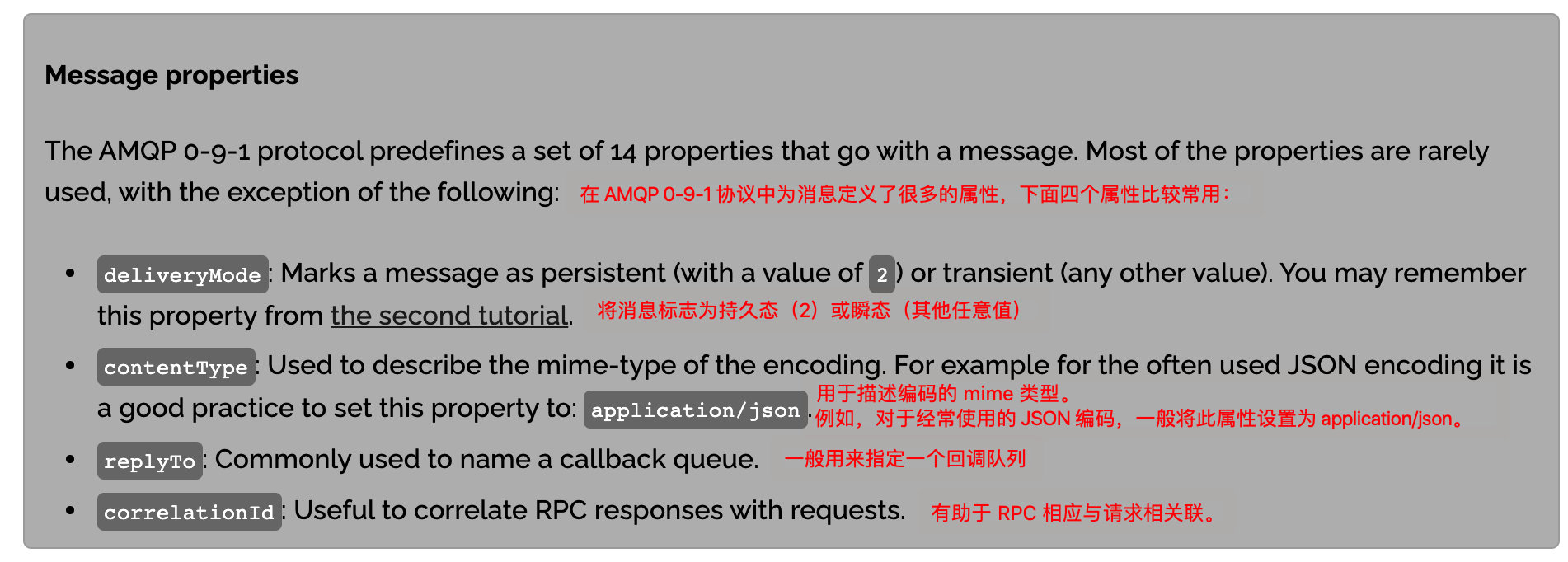# 6. RabbitMQ 支持的消息模型

# 6.0 模型总览


注意:使用的时候需要先在项目中注入 rabbitmq 的依赖坐标:
<dependency>
<groupId>com.rabbitmq</groupId>
<artifactId>amqp-client</artifactId>
<version>5.9.0</version>
</dependency>
# 6.1 Hello World 模型

在上图的模型中,有以下概念:
- P:生产者,也就是要发送消息的程序
- C:消费者:消息的接受者,会一直等待消息到来。
- queue:消息队列,图中红色部分。类似一个邮箱,可以缓存消息;生产者向其中投递消息,消费者从其中取出消息。
# 6.1.1 生产者
public class Provider {
public static void main(String[] args) throws IOException, TimeoutException {
//1. 创建连接工厂
ConnectionFactory connectionFactory = new ConnectionFactory();
//2. 配置连接工厂
connectionFactory.setHost("172.16.208.138");
connectionFactory.setPort(5672);
connectionFactory.setUsername("hedon");
connectionFactory.setPassword("hedon");
connectionFactory.setVirtualHost("/hedon");
//3. 获取连接对象
Connection connection = connectionFactory.newConnection();
//4. 创建通道
Channel channel = connection.createChannel();
/**
* 5. 申明队列
*
* 参数1(queue):队列名,没有的话会自动创建
* 参数2(durable):是否持久化,在 RabbitMQ 重启时是否会自动删除该队列(即使保存队列,队列中的消息还是会被清空)
* 参数3(exclusive):是否独占队列
* 参数4(autoDelete):当队列中没有消息时是否自动删除
* 参数5(arguments):队列的其他属性,这里可以填构造方法中的一些参数
*/
channel.queueDeclare("hello",false,false,false,null);
/
/**
* 6. 发布信息
*
* 参数1(exchange):交换机,直连模式不需要交换机
* 参数2(routingKey):路由key,直连模式就是对列名称
* 参数3(props):其他属性
* 参数4(body):要发布的信息,需要转为字节码
*/
channel.basicPublish("","hello",null,"hello rabbitmq".getBytes());
//7. 关闭通道
channel.close();
//8. 关闭连接
connection.close();
}
}
生产者运行6次,会发送6条消息到通道中:

# 6.1.2 消费者
public class Consumer {
public static void main(String[] args) throws IOException, TimeoutException {
//1. 创建连接工厂
ConnectionFactory connectionFactory = new ConnectionFactory();
//2. 配置连接工厂
connectionFactory.setHost("172.16.208.138");
connectionFactory.setPort(5672);
connectionFactory.setUsername("hedon");
connectionFactory.setPassword("hedon");
connectionFactory.setVirtualHost("/hedon");
//3. 获取连接对象
Connection connection = connectionFactory.newConnection();
//4. 创建通道
Channel channel = connection.createChannel();
/**
* 5. 申明队列 => 这里需要跟发布者一一对应
*
* 参数1(queue):队列名,没有的话会自动创建
* 参数2(durable):是否持久化,在 RabbitMQ 重启时是否会自动删除该队列(即使保存队列,队列中的消息还是会被清空)
* 参数3(exclusive):是否独占队列
* 参数4(autoDelete):当队列中没有消息时是否自动删除
* 参数5(arguments):队列的其他属性,这里可以填构造方法中的一些参数
*/
channel.queueDeclare("hello",false,false,false,null);
/**
* 6. 获取消息
*
* 参数1(queue):队列名
* 参数2(autoAck):如果服务器应考虑消息传递后已确认,则为true
* 参数3(callback):一个实现了 Consumer 接口的对象
*/
channel.basicConsume("hello",true,new DefaultConsumer(channel){
/**
* 7. 处理信息的接收
*
* @param consumerTag 消费者标签
* @param envelope 消息的打包数据
* @param properties AMQP的属性,消息的内容头信息
* @param body 信息的内容
* @throws IOException
*/
@Override
public void handleDelivery(String consumerTag, Envelope envelope, AMQP.BasicProperties properties, byte[] body) throws IOException {
//输出消息
System.out.println(new String(body));
}
});
//这里不关闭的话会一直监听,一但有消息进入,就会输出。
//channel.close();
//connection.close();
}
}
消费者运行,会一直监听,把所有消息都输出,如果有新的消息进入,也会输出:


# 6.2 Work Queues 模型
Work queues,也被称为(Task queues),任务模型。当消息处理比较耗时的时候,可能生产消息的速度会远远大于消息的消费速度。长此以往,消息就会堆积越来越多,无法及时处理。此时就可以使用work 模型:让多个消费者绑定到一个队列,共同消费队列中的消息。队列中的消息一旦消费,就会消失,因此任务是不会被重复执行的。

# 6.2.1 平均消费
# 6.2.1.1 生产者
public class Provider {
public static void main(String[] args) throws IOException {
//1. 通过自行封装的方法获取连接对象
Connection connection = RabbitMqUtils.getConnection();
//2. 获取通道对象
Channel channel = connection.createChannel();
//3. 申明队列
channel.queueDeclare("work",true,false,false,null);
//4. 发布信息
for (int i = 0; i < 100; i++) {
channel.basicPublish("","work",null,("发布消息"+i).getBytes());
}
//5. 通过自行封装的方法关闭资源
RabbitMqUtils.closeChannelAndConnection(channel,connection);
}
}
# 6.2.1.2 消费者一
public class ConsumerOne {
public static void main(String[] args) throws IOException {
//1. 通过自行封装的方法获取连接对象
Connection connection = RabbitMqUtils.getConnection();
//2. 获取通道对象
Channel channel = connection.createChannel();
//3. 申明队列
channel.queueDeclare("work",true,false,false,null);
//4. 消费消息
channel.basicConsume("work",new DefaultConsumer(channel){
@Override
public void handleDelivery(String consumerTag, Envelope envelope, AMQP.BasicProperties properties, byte[] body) throws IOException {
System.out.println("这是消费者1在消费信息:" + new String(body));
}
});
}
}
# 6.2.1.3 消费者二
public class ConsumerTwo {
public static void main(String[] args) throws IOException {
//1. 通过自行封装的方法获取连接对象
Connection connection = RabbitMqUtils.getConnection();
//2. 获取通道对象
Channel channel = connection.createChannel();
//3. 申明队列
channel.queueDeclare("work",true,false,false,null);
//4. 消费消息
channel.basicConsume("work",new DefaultConsumer(channel){
@Override
public void handleDelivery(String consumerTag, Envelope envelope, AMQP.BasicProperties properties, byte[] body) throws IOException {
System.out.println("这是消费者2在消费信息:" + new String(body));
}
});
}
}
# 6.2.1.4 测试
先运行两个消费者,然后运行生产者产生消息,观察两个消费者消费消息的情况:


通过上图我们可以发现 work 模型在默认情况下,RabbitMQ 会按顺序将每个消息发送给下一个消费者者。平均而言,每个消费者都会收到相同数量的消息。这种分发消息的方式称为轮询。
# 6.2.2 能者多劳
# 6.2.2.1 平均消费可能出现的问题
在平均消费模式中,消费者只要从队列中拿到消息,就立刻发送确认机制,有可能在处理消息的时候就突然宕机了或者出现意外了,这样消息还没来得及消费就遗失了,就造成业务数据的丢失。
另外,也有可能两个消费者处理消息的效率不一样,就有可能造成一个消费者已经消费完消息然后闲着,而另外一个消费者拿到了消息,却一直处于处理消息的状态,造成资源的浪费。
所以我们需要做==三件事==:
关闭消息自动确认机制
//第二个参数 = false:关闭消息自动确认机制 channel.basicConsume(队列名,false,new DefaultConsumer(channel){ .... })不能一次性把消息交给消费者
channel.basicQos(1); //每一次只消费一个消息主动进行确认
//参数1:确认的是队列中的哪个具体消息 //参数2:是否开启多个消息同时确认 channel.basicAck(envelope.getDeliveryTag(),false);
# 6.2.2.2 修改消费者

# 6.2.2.3 再次测试


从上述结果中可以发现,由于我先前修改了消费者1的代码,让它的执行时间边长,所以它就只来得及接收并处理一条信息,其他信息都被消费者2接收并处理了,这样就达到了“能者多劳”的效果了。
# 6.3 Fanout 模型
fanout 模型是一种广播模型,也就是一个生产者可以发一个消息,进行广播,让多个消费者消费同一个消息。

在广播模式下,消息发送流程是这样的:
- 可以有多个消费者
- 每个消费者有自己的queue(队列)
- 每个队列都要绑定到Exchange(交换机)
- 生产者发送的消息,只能发送到交换机,交换机来决定要发给哪个队列,生产者无法决定。
- 交换机把消息发送给绑定过的所有队列
- 队列的消费者都能拿到消息。实现一条消息被多个消费者消费
# 6.3.1 生产者
public class Provider {
public static void main(String[] args) throws IOException {
//1. 通过自行封装的方法获取连接对象
Connection connection = RabbitMqUtils.getConnection();
//2. 获取通道对象
Channel channel = connection.createChannel();
//3. 声明交换机 => fanout 模式的交换机 type 需要制定为 fanout
channel.exchangeDeclare("logs","fanout");
//4. 广播消息
channel.basicPublish("logs","",null,"这是一条广播".getBytes());
//5. 关闭资源
RabbitMqUtils.closeChannelAndConnection(channel,connection);
}
}
# 6.3.2 消费者一
public class ConsumerOne {
public static void main(String[] args) throws IOException {
//1. 通过自行封装的方法获取连接对象
Connection connection = RabbitMqUtils.getConnection();
//2. 获取通道对象
Channel channel = connection.createChannel();
//3. 绑定交换机 => fanout 模式的交换机 type 需要制定为 fanout
channel.exchangeDeclare("logs","fanout");
//4. 创建临时队列,这里会随机生成一个队列名称
String queue = channel.queueDeclare().getQueue();
//5. 将临时队列绑定到交换机上,fanout模式暂时还不需要routingKey
channel.queueBind(queue,"logs","");
//6. 消费消息
channel.basicConsume(queue,true,new DefaultConsumer(channel){
@Override
public void handleDelivery(String consumerTag, Envelope envelope, AMQP.BasicProperties properties, byte[] body) throws IOException {
System.out.println("消费者1接收到消息:"+new String(body));
}
});
}
}
消费者二同理。
# 6.3.3 测试


# 6.4 Routing 模型
在 Fanout 模式中,一条消息,会被所有订阅的队列都消费。但是,在某些场景下,我们希望不同的消息被不同的队列消费。这时就要用到 Direct 类型的Exchange。

在 Direct 模型下:
- 队列与交换机的绑定,不能是任意绑定了,而是要指定一个
RoutingKey(路由key) - 消息的发送方在 向 Exchange发送消息时,也必须指定消息的
RoutingKey。 - Exchange不再把消息交给每一个绑定的队列,而是根据消息的
Routing Key进行判断,只有队列的Routingkey与消息的Routing key完全一致,才会接收到消息
图解:
- P:生产者,向Exchange发送消息,发送消息时,会指定一个routing key。
- X:Exchange(交换机),接收生产者的消息,然后把消息递交给 与routing key完全匹配的队列
- C1:消费者,其所在队列指定了需要routing key 为 error 的消息
- C2:消费者,其所在队列指定了需要routing key 为 info、error、warning 的消息
# 6.6.1 生产者
public class Provider {
public static void main(String[] args) throws IOException {
//1. 通过自行封装的方法获取连接对象
Connection connection = RabbitMqUtils.getConnection();
//2. 获取通道对象
Channel channel = connection.createChannel();
//3. 声明交换机 => routing 模型的交换机类型是 direct
channel.exchangeDeclare("ex_direct","direct");
//4. 广播消息 => 一条是 error,另一条是 info
channel.basicPublish("ex_direct","error",null,"这是一条error广播".getBytes());
channel.basicPublish("ex_direct","info",null,"这是一条info广播".getBytes());
//5. 关闭资源
RabbitMqUtils.closeChannelAndConnection(channel,connection);
}
}
# 6.6.2 消费者一
public class ConsumerOne {
public static void main(String[] args) throws IOException {
//1. 通过自行封装的方法获取连接对象
Connection connection = RabbitMqUtils.getConnection();
//2. 获取通道对象
Channel channel = connection.createChannel();
//3. 绑定交换机 => routing 模型的交换机类型是 direct
channel.exchangeDeclare("ex_direct","direct");
//4. 创建临时队列
String queue = channel.queueDeclare().getQueue();
//5. 将临时队列绑定到交换机上 => 消费者1只能消费 routingKey 为 error 的消息
channel.queueBind(queue,"ex_direct","error");
//6. 消费消息
channel.basicConsume(queue,true,new DefaultConsumer(channel){
@Override
public void handleDelivery(String consumerTag, Envelope envelope, AMQP.BasicProperties properties, byte[] body) throws IOException {
System.out.println("消费者1接收到消息:"+new String(body));
}
});
}
}
# 6.6.3 消费者二
public class ConsumerTwo {
public static void main(String[] args) throws IOException {
Connection connection = RabbitMqUtils.getConnection();
Channel channel = connection.createChannel();
channel.exchangeDeclare("ex_direct","direct");
String queue = channel.queueDeclare().getQueue();
//消费者2可以消费 routingKey 为 info、error 和 warning 的消息
channel.queueBind(queue,"ex_direct","info");
channel.queueBind(queue,"ex_direct","error");
channel.queueBind(queue,"ex_direct","warning");
channel.basicConsume(queue,true,new DefaultConsumer(channel){
@Override
public void handleDelivery(String consumerTag, Envelope envelope, AMQP.BasicProperties properties, byte[] body) throws IOException {
System.out.println("这是消费者2在消费消息:"+new String(body));
}
});
}
}
# 6.6.4 测试


# 6.5 Topics 模型
Topics类型的Exchange与Direct相比,都是可以根据RoutingKey把消息路由到不同的队列。只不过Topic类型Exchange可以让队列在绑定Routing key 的时候使用通配符!这种模型Routingkey 一般都是由一个或多个单词组成,多个单词之间以”.”分割,例如: item.insert

# 统配符
* 匹配不多不少恰好1个词
# 匹配一个或多个词
# 如:
audit.# 匹配audit.irs.corporate或者 audit.irs 等
audit.* 只能匹配 audit.irs
# 6.5.1 生产者
public class Provider {
public static void main(String[] args) throws IOException {
//1. 通过自行封装的方法获取连接对象
Connection connection = RabbitMqUtils.getConnection();
//2. 获取通道对象
Channel channel = connection.createChannel();
//3. 声明交换机 => topics 模型的交换机类型为 topic
channel.exchangeDeclare("ex_topic","topic");
//4. 广播消息
channel.basicPublish("ex_topic","logs",null,"这是一条 logs 广播".getBytes());
channel.basicPublish("ex_topic","logs.a",null,"这是一条 logs.a 信息".getBytes());
channel.basicPublish("ex_topic","logs.a.b",null,"这是一条 logs.a.b 广播".getBytes());
channel.basicPublish("ex_topic","logs.a.b.c",null,"这是一条 logs.a.b.c 广播".getBytes());
//5. 关闭资源
RabbitMqUtils.closeChannelAndConnection(channel,connection);
}
}
# 6.5.2 消费者一
public class ConsumerOne {
public static void main(String[] args) throws IOException {
//1. 通过自行封装的方法获取连接对象
Connection connection = RabbitMqUtils.getConnection();
//2. 获取通道对象
Channel channel = connection.createChannel();
//3. 绑定交换机 => topics 模型的交换机类型为 topic
channel.exchangeDeclare("ex_topic","topic");
//4. 创建临时队列
String queue = channel.queueDeclare().getQueue();
//5. 将临时队列绑定到交换机上 => 消费者1只能消费 routingKey 为 error 的消息
//routingKey 的每个单词之间用"."来分割,通配符 * 表示只能匹配1个单词,如 logs.a
channel.queueBind(queue,"ex_topic","logs.*");
//6. 消费消息
channel.basicConsume(queue,true,new DefaultConsumer(channel){
@Override
public void handleDelivery(String consumerTag, Envelope envelope, AMQP.BasicProperties properties, byte[] body) throws IOException {
System.out.println("消费者1接收到消息:"+new String(body));
}
});
}
}
# 6.5.3 消费者二
public class ConsumerTwo {
public static void main(String[] args) throws IOException {
Connection connection = RabbitMqUtils.getConnection();
Channel channel = connection.createChannel();
channel.exchangeDeclare("ex_topic","topic");
String queue = channel.queueDeclare().getQueue();
//消费者2可以消费 routingKey 为 info、error 和 warning 的消息
//每个单词之间用"."来分割,通配符 # 表示可以匹配多个单词,如 logs.a,logs.a.b
channel.queueBind(queue,"ex_topic","logs.#");
channel.basicConsume(queue,true,new DefaultConsumer(channel){
@Override
public void handleDelivery(String consumerTag, Envelope envelope, AMQP.BasicProperties properties, byte[] body) throws IOException {
System.out.println("这是消费者2在消费消息:"+new String(body));
}
});
}
}
# 6.5.4 测试
如下图,消费者1的 routingKey 为“logs.*”,所以 logs. 后面必须有一个单词才能被消费者1消费,而消费者2的 routingKey 为“logs.#”,所以 logs. 后面没有单词或者有多个单词都可以被消费者2消费。


# 6.6 RPC 模型
在 Work Queues 模型中,我们学习了如何使用工作队列在多个工作人员之间分配耗时的任务。
但是,如果我们需要在远程计算机上运行功能并等待结果怎么办?那就可以用 RPC 模型(远程过程调用)。
我们将使用 RabbitMQ 构建RPC系统:客户端和可伸缩 RPC 服务器。由于我们没有值得分配的耗时任务,因此我们将创建一个虚拟 RPC服务,该服务返回斐波那契数。

==图解:==
对于RPC请求,客户端发送一条消息,该消息具有两个属性:replyTo(设置为仅为该请求创建的匿名互斥队列)和correlationId(设置为每个请求的唯一值)。
该请求被发送到rpc_queue队列。
RPC工作程序(又名:服务器)正在等待该队列上的请求。出现请求时,它会使用 replyTo 字段中的队列来完成工作,并将消息和结果发送回客户端。
客户端等待答复队列中的数据。出现消息时,它将检查correlationId属性。如果它与请求中的值匹配,则将响应返回给应用程序。
==补充:消息的属性==

# 6.6.1 客户端
public class RPCClient {
private Connection connection;
private Channel channel;
private String requestQueueName = "rpc_queue"; //发送请求的队列名称
public static void main(String[] args) throws IOException, InterruptedException {
//初始化 RPCClient
RPCClient rpcClient = new RPCClient();
rpcClient.connection = RabbitMqUtils.getConnection();
rpcClient.channel = rpcClient.connection.createChannel();
//发送 request 请求信息
for (int i = 0; i < 5; i++) {
String i_str = Integer.toString(i);
System.out.println("现在客户端希望计算 fic("+i+")");
String response = rpcClient.call(i_str);
System.out.println("现在计算出来 fic("+i+") = "+ response);
}
//关闭资源
close(rpcClient);
}
//发送请求,希望调用远程的函数
public String call(String message) throws IOException, InterruptedException {
//定义一个相关ID
final String correlationId = UUID.randomUUID().toString();
//回调队列
String replyQueueName = channel.queueDeclare().getQueue();
//定义消息属性
AMQP.BasicProperties basicProperties = new AMQP.BasicProperties
.Builder()
.correlationId(correlationId) //设置相关ID
.replyTo(replyQueueName) //设置回调队列
.build();
//存储相应信息
final BlockingQueue<String> response = new ArrayBlockingQueue<>(1);
//发送消息
channel.basicPublish("",requestQueueName,basicProperties,message.getBytes("UTF-8"));
//消费消息
String ctag = channel.basicConsume(replyQueueName, true
//参数3:服务器端传过来的回调对象
, new DeliverCallback() {
@Override
public void handle(String consumerTag, Delivery message) throws IOException {
if (message.getProperties().getCorrelationId().equals(correlationId)) {
response.offer(new String(message.getBody(), "UTF-8"));
}
}
}, new CancelCallback() {
@Override
public void handle(String consumerTag) throws IOException {
}
});
String result = response.take();
channel.basicCancel(ctag);
return result;
}
//关闭资源
public static void close(RPCClient rpcClient){
RabbitMqUtils.closeChannelAndConnection(rpcClient.channel,rpcClient.connection);
}
}
# 6.6.2 服务端
public class RPCServer {
//定义队列名称
private static final String RPC_QUEUE_NAME = "rpc_queue";
//计算斐波那契数列
public static int fic(int a){
if (a == 0) return 0;
if (a == 1) return 1;
return fic(a-1) + fic(a-2);
}
public static void main(String[] args) throws IOException {
//调用自行封装的工具类获取连接对象
Connection connection = RabbitMqUtils.getConnection();
//获取通道
Channel channel = connection.createChannel();
//声明队列
channel.queueDeclare(RPC_QUEUE_NAME,false,false,false,null);
//清除队列
channel.queuePurge(RPC_QUEUE_NAME);
//每次处理一条信息
channel.basicQos(1);
//定义一个监听器
Object monitor = new Object();
//定义回调信息
DeliverCallback deliverCallback = new DeliverCallback() {
/**
* @param consumerTag 消费者标签,可以与消费者建立联系
* @param message 消费者发送过来的消息(消息属性、消息封装体、消息没人)
*/
@Override
public void handle(String consumerTag, Delivery message) throws IOException {
//定义信息属性
AMQP.BasicProperties basicProperties = new AMQP.BasicProperties
.Builder()
.correlationId(message.getProperties().getCorrelationId()) //指明关联ID
.build();
//定义相应信息
String response = "";
//解析request信息
try{
String s = new String(message.getBody(),"UTF-8");
int i = Integer.parseInt(s);
System.out.println("正在计算 fic("+i+")");
response += fic(i);
}catch (Exception e){
e.printStackTrace();
}finally {
//发布 response 消息
channel.basicPublish("",message.getProperties().getReplyTo(),basicProperties,response.getBytes("UTF-8"));
//手动确认信息
channel.basicAck(message.getEnvelope().getDeliveryTag(),false);
//RabbitMq 消费者工作线程通知 RPC 服务器所有者线程
synchronized (monitor){
/**
* notify()
*
* 唤醒处于等待的线程
*/
monitor.notify();
}
}
}
};
//消费客户端发送过来的请求消息
channel.basicConsume(RPC_QUEUE_NAME, false, deliverCallback, new CancelCallback() {
// 等待并准备好使用来自RPC客户端的消息
@Override
public void handle(String consumerTag) throws IOException {
while (true){
synchronized (monitor){
try {
/**
* wait()
*
* 使得当前线程立刻停止运行,处于等待状态(WAIT),
* 并将当前线程置入锁对象的等待队列中,
* 直到被通知(notify)或被中断为止。
*/
monitor.wait();
}catch (InterruptedException e){
e.printStackTrace();
}
}
}
}
});
}
}
# 6.6.3 测试


# 6.6.4 图解上述两段代码
上面两段代码是笔者模仿官网代码写出来的,刚开始写的时候也是一头雾水,现尝试画张图来加深理解。

# 6.7 Publisher Confirms 模型
待补。
